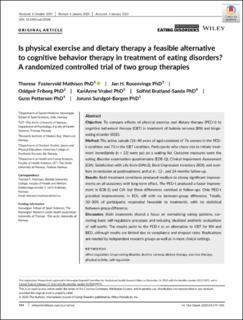Is physical exercise and dietary therapy a feasible alternative to cognitive behavior therapy in treatment of eating disorders? A randomized controlled trial of two group therapies
Mathisen, Therese Fostervold; Friborg, Oddgeir; Bratland-Sanda, Solfrid; Pettersen, Gunn; Sundgot-Borgen, Jorunn; Rosenvinge, Jan H.; Vrabel, Kari-Anne
Peer reviewed, Journal article
Published version
Permanent lenke
https://hdl.handle.net/11250/2675702Utgivelsesdato
2020Metadata
Vis full innførselSamlinger
- Artikler / Articles [2096]
- Publikasjoner fra Cristin [1084]
Sammendrag
Objective: To compare effects of physical exercise and dietary therapy (PED‐t) to cognitive behavioral therapy (CBT) in treatment of bulimia nervosa (BN) and binge‐eating disorder (BED).
Method: The active sample (18–40 years of age) consisted of 76 women in the PED‐t condition and 73 in the CBT condition. Participants who chose not to initiate treatment immediately (n = 23) were put on a waiting list. Outcome measures were the eating disorder examination questionnaire (EDE‐Q), Clinical Impairment Assessment (CIA), Satisfaction with Life Scale (SWLS), Beck Depression Inventory (BDI), and numbers in remission at posttreatment, and at 6‐, 12‐, and 24‐months follow‐up.
Results: Both treatment conditions produced medium to strong significant improvements on all outcomes with long‐term effect. The PED‐t produced a faster improvement in EDE‐Q and CIA, but these differences vanished at follow‐ups. Only PED‐t provided improvements in BDI, still with no between‐group difference. Totally, 30–50% of participants responded favorable to treatments, with no statistical between‐group difference.
Discussion: Both treatments shared a focus on normalizing eating patterns, correcting basic self‐regulatory processes and reducing idealized aesthetic evaluations of self‐worth. The results point to the PED‐t as an alternative to CBT for BN and BED, although results are limited due to compliance and dropout rates. Replications are needed by independent research groups as well as in more clinical settings.
Beskrivelse
This is an open access article under the terms of the Creative Commons Attribution License, which permits use, distribution and reproduction in any medium, provided the original work is properly cited.
Tidsskrift
International Journal of Eating DisordersOpphavsrett
© 2020 The AuthorsBeslektede innførsler
Viser innførsler beslektet ved tittel, forfatter og emneord.
-
Objectively measured sedentary time, physical activity and kidney function in people with recently diagnosed Type 2 diabetes: a prospective cohort analysis
Guo, Vivianyawei; Brage, Søren; Ekelund, Ulf; Griffin, Simon J.; Simmons, Rebecca K. (Journal article; Peer reviewed, 2015-09-08)Aim: To assess the prospective association between objectively measured physical activity and kidney function over 4 years in people with Type 2 diabetes. Methods: Individuals (120 women and 206 men) participating in the ... -
The London 2012 Summer Olympic Games: An analysis of usage of the Olympic Village ‘Polyclinic’ by competing athletes
Vanhegan, Ivor S.; Palmer-Green, Debbie; Soligard, Torbjørn; Steffen, Kathrin; O'Connor, Philip; Bethapudi, Sarath; Budgett, Richard; Haddad, Fares S.; Engebretsen, Lars (Journal article; Peer reviewed, 2013-03-06)The London 2012 Summer Olympic Games involved 10 568 elite athletes representing 204 competing nations. To manage the varied healthcare needs of this diverse population, a Polyclinic was constructed in the athletes’ village. ... -
Segmentale stabilisation zur behandlung von lumbalen rückenschmerzen: ein systematischer review
Kriese, Melanie; Clijsen, Ron; Cabri, Jan (Journal article; Peer reviewed, 2010)BACKGROUND: Segmental Stabilizing Exercises (SSE) has a strong theoretical basis in treatment and prevention of Low Back Pain (LBP). The clinical effectiveness has not been clearly established. STUDY DESIGN: A systematic ...
